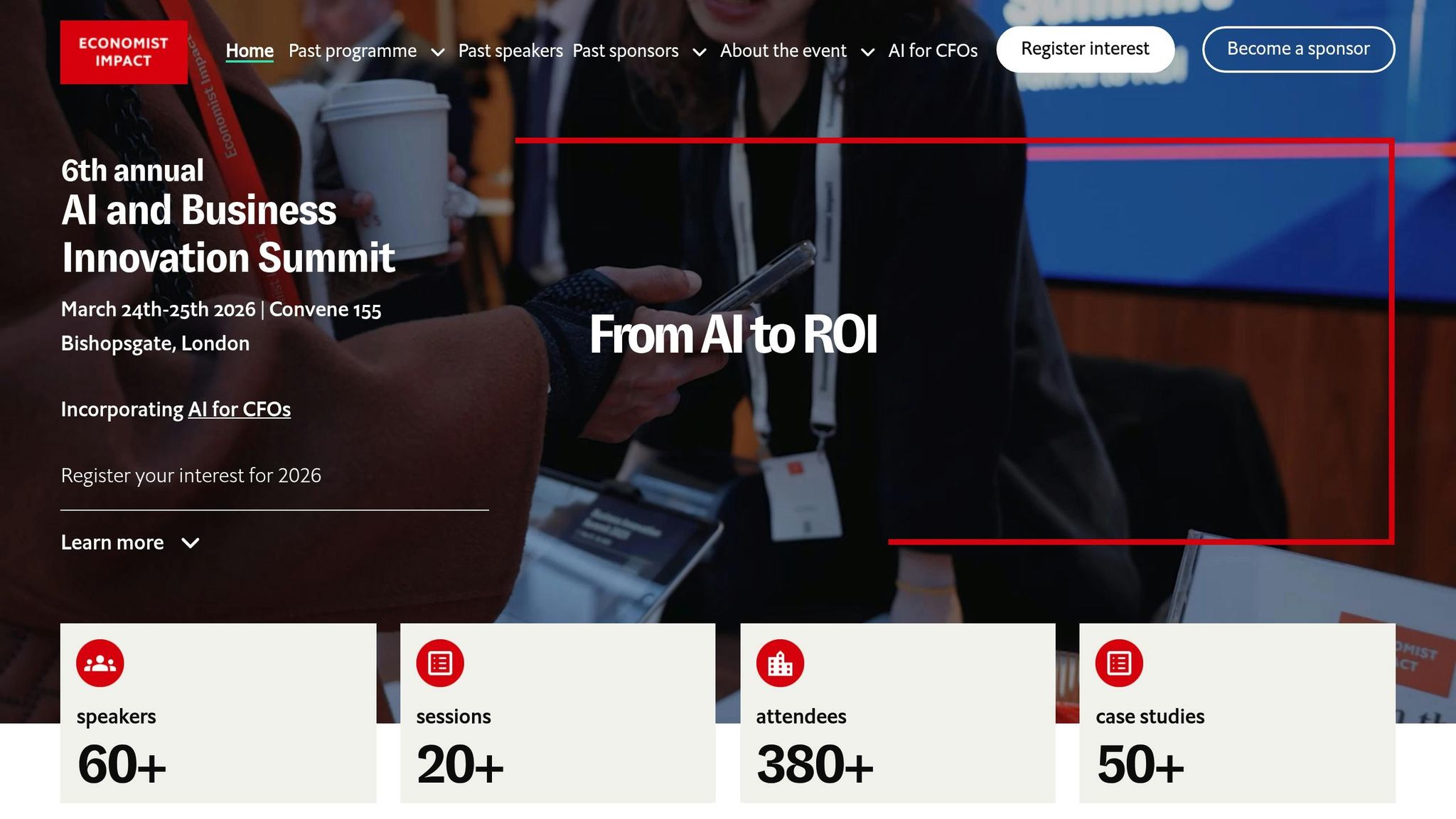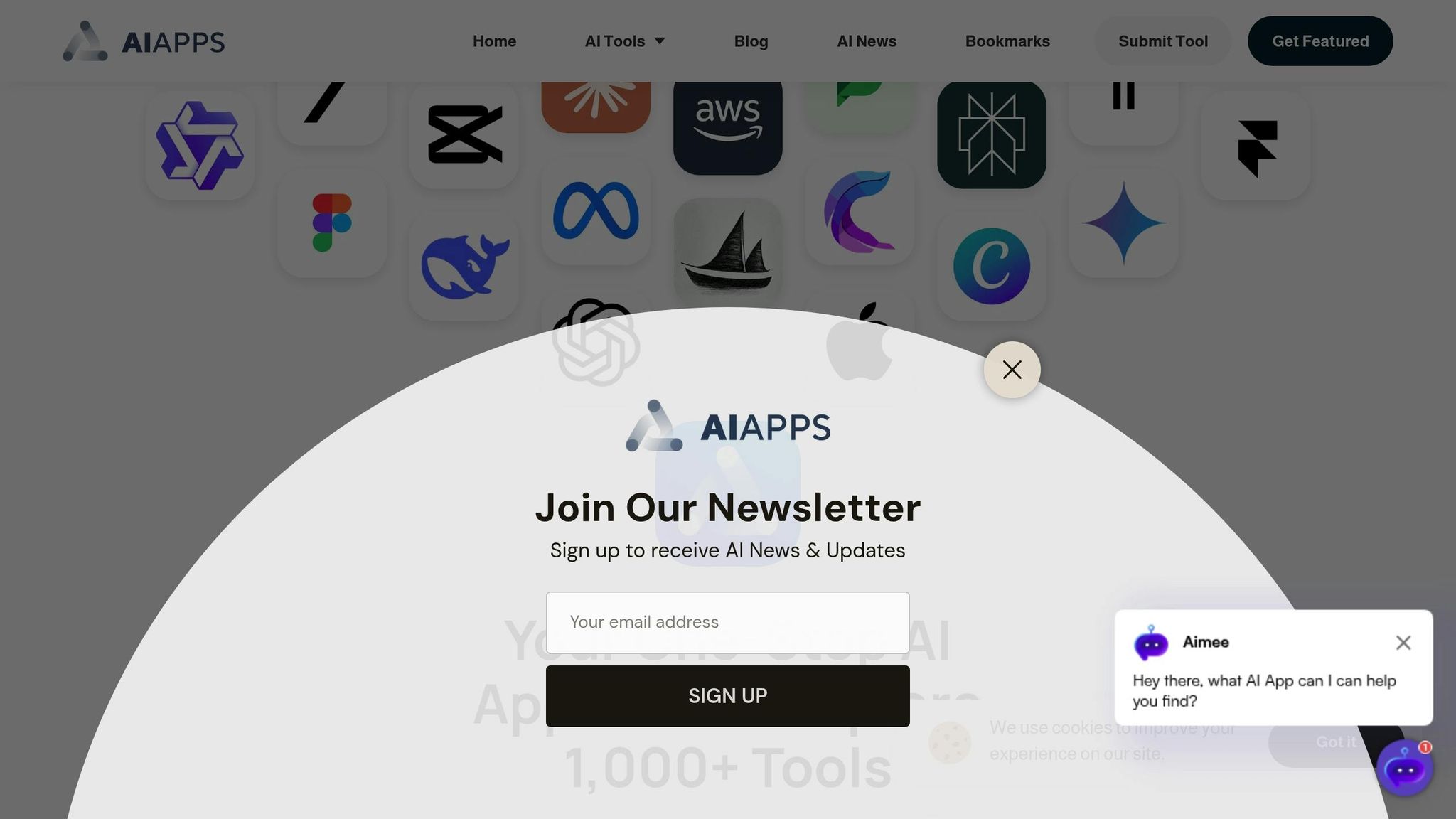AI ROI (Return on Investment) is about measuring the financial value your business gets from AI tools compared to the costs. It ensures you’re spending wisely and helps you decide which tools truly benefit your business. This guide covers:
- How to calculate AI ROI: Use a simple formula: [(Net Benefit ÷ Total Cost) × 100%].
- Key metrics to track: Financial gains (cost savings, revenue growth) and non-financial benefits (better customer experience, employee satisfaction).
- Frameworks to evaluate ROI: Payback Period, Net Present Value (NPV), Internal Rate of Return (IRR), and Total Cost of Ownership (TCO).
- Steps to maximize ROI: Start with small projects, monitor performance regularly, and focus on high-impact tools.
- Choosing the best tools: Platforms like AI Apps can help you compare and select from over 1,000 AI tools.
AI ROI: 7 Insights from the Economist Business Innovation Summit

Key Metrics for Measuring AI ROI
Tracking the right metrics is essential for evaluating the success of AI investments. Without a clear framework, it’s hard to determine whether your AI tools are delivering value. The focus should be on both financial returns and operational improvements that AI brings to your business. Let’s break down the key formulas and frameworks to measure ROI effectively.
Basic ROI Formula and How to Apply It
The simplest way to calculate AI ROI is by using this formula: [(Net Benefit ÷ Total Cost) × 100%]. Here’s how it works:
- Net Benefit: Total gains from the AI investment minus total costs.
- Total Cost: All expenses, including software licenses, training, implementation, and ongoing maintenance.
For example, imagine an AI-powered inventory system that costs $15,000 per year but reduces inventory waste by $25,000. The net benefit is $10,000, and the ROI would be ($10,000 ÷ $15,000) × 100% = 66.7%. In this case, every dollar spent on the system returns $0.67 in value.
This formula is particularly useful for small businesses with clearly defined AI applications. For instance, a local restaurant using a $200 monthly AI scheduling tool to save $800 achieves a 300% ROI. Such straightforward calculations help determine whether an AI tool is worth the investment or if it’s time to explore alternatives.
However, to get an accurate ROI, don’t overlook hidden costs like employee training, data preparation, and system integration. Including these ensures a realistic view of the investment’s value.
ROI Assessment Frameworks
While the basic formula is helpful, additional frameworks provide deeper insights into your AI investments:
- Payback Period Analysis: This method calculates how long it takes to recover your initial investment. For example, if you spend $10,000 on an AI chatbot that saves $2,000 monthly, your payback period is five months.
- Net Present Value (NPV): Ideal for long-term projects, NPV accounts for the time value of money. It recognizes that savings today are more valuable than future savings, making it perfect for AI systems that improve over time, like machine learning models.
- Internal Rate of Return (IRR): IRR helps you compare the profitability of AI investments with other opportunities. For example, if a project has an IRR of 25%, you can weigh it against other options to decide where your money will work hardest.
- Total Cost of Ownership (TCO): TCO looks at all direct and indirect costs across the AI tool’s lifecycle. This framework helps avoid surprises by factoring in long-term expenses like upgrades and support.
Here’s a quick comparison of these frameworks:
| Framework | Best For | Time Horizon | Key Benefit |
|---|---|---|---|
| Payback Period | Quick wins, cash flow concerns | 6-24 months | Easy to calculate and understand |
| NPV | Long-term strategic investments | 2+ years | Accounts for time value of money |
| IRR | Comparing multiple opportunities | 1-5 years | Simplifies investment comparison |
| TCO | Comprehensive cost analysis | Full lifecycle | Reveals hidden and long-term costs |
Measuring Financial and Non-Financial Benefits
Financial benefits are often the easiest to quantify. These include:
- Cost savings: Examples include reducing manual labor, cutting operational expenses, or minimizing errors.
- Revenue growth: AI might help you reach more customers, improve pricing strategies, or uncover new markets.
- Efficiency gains: Automating tasks like predictive maintenance can save significant amounts in downtime and extend equipment life.
For example, a manufacturing company using AI for predictive maintenance could save $50,000 annually in downtime costs while extending machine life by 15%. These are measurable, trackable benefits.
On the other hand, non-financial benefits are harder to measure but just as important. For example:
- AI can improve employee satisfaction by handling repetitive tasks, reducing turnover costs.
- Enhanced customer experiences through AI personalization can boost customer loyalty and lifetime value, even if the immediate revenue impact isn’t obvious.
Some benefits, like process improvements, bridge financial and non-financial gains. Consider an AI tool that reduces invoice processing time from 30 minutes to 5 minutes. This not only saves labor costs but also improves accuracy and employee morale. You can calculate the savings based on hourly wages while also recognizing the operational advantages.
Customer satisfaction metrics, such as Net Promoter Score (NPS) or retention rates, can also highlight AI’s impact. While these metrics don’t directly translate into dollars, they often correlate with long-term revenue growth and lower customer acquisition costs.
To measure these benefits effectively, start by establishing baseline metrics before deploying AI tools. This allows for clear before-and-after comparisons. Track these metrics consistently, as AI’s value often grows over time. For instance, an AI-powered customer service tool may show modest improvements initially but deliver greater value as it learns from more interactions.
Balancing quantifiable metrics with qualitative improvements is crucial. While a 20% reduction in response time is a clear win, the enhanced customer experience and brand reputation it creates can drive long-term success. By capturing both, you’ll gain a complete picture of your AI investment’s impact.
How to Conduct AI Cost-Benefit Analysis
A thorough cost-benefit analysis is essential to ensure AI investments align with your business goals and deliver meaningful value.
Finding the Right Business Processes for AI
Start by identifying tasks that consume significant time and resources. AI often excels in areas like customer service, inventory management, and financial reporting, where its reliability can save time and reduce errors.
For example, high-volume customer interactions are a prime candidate for automation. If your team spends hours answering repetitive inquiries, tools like chatbots or automated response systems can handle these routine tasks. This frees up your staff to focus on more complex, high-value customer concerns - especially in businesses with predictable service needs.
Another area to consider is data-heavy processes. AI can sift through massive datasets much faster than humans, making it ideal for market research, financial analysis, or quality control. For instance, a manufacturing company might use AI-powered predictive maintenance to monitor equipment and prevent costly breakdowns.
However, steer clear of processes requiring significant human judgment, creativity, or nuanced decision-making. AI thrives on clear patterns and rules but struggles in areas where flexibility or subjective judgment is key. Similarly, tasks tied to regulatory compliance should be approached cautiously, as errors in these areas can be costly.
To pinpoint opportunities, evaluate pain points in your operations. Processes that frequently cause bottlenecks, generate customer complaints, or frustrate employees are good candidates for improvement. Once you've identified these areas, collect performance data to establish a baseline for comparison.
Collecting and Analyzing Current Performance Data
Establishing baseline metrics is critical for measuring the impact of AI solutions. While this step takes time, it provides the foundation for meaningful analysis.
Start by tracking time-based metrics, resource allocation, and error rates for the processes you’re considering. Document how long tasks take, how much staff time is spent (including associated costs), and the frequency of errors or rework. For instance, if a process has a 5% error rate and each mistake costs $100, you can easily quantify the potential savings.
Next, gather customer satisfaction data tied to these processes. Metrics like response times, resolution rates, and satisfaction scores will help you measure how automation impacts the customer experience.
Don’t forget to collect financial data related to current operations. This includes direct costs, overhead, and any external expenses, such as software or tools. A complete financial picture is necessary for accurate comparisons later.
Lastly, account for seasonal variations and trends in your data. Some processes may perform better during certain times of the year. Understanding these fluctuations will help you set realistic expectations for AI performance.
Calculating Costs and Estimating Benefits
With your data in hand, you can now quantify costs and project potential benefits.
Start by evaluating software and licensing costs. Review pricing models - whether they’re per user, per transaction, or usage-based - and factor in potential price increases. Consider whether your business growth might require additional features down the line.
Implementation costs are often higher than anticipated. These include data migration, system integration, and custom development expenses. Don’t overlook professional service fees for setup and configuration, as well as costs tied to testing phases or unexpected delays.
Factor in training expenses for both employees and the system itself. Staff will need time to adapt to new tools, which might temporarily reduce productivity. Additionally, some AI systems require training on your specific data, which could involve extra consulting fees.
Ongoing operational costs are another consideration. These include maintenance, updates, and support. If you’re using cloud-based AI services, expect monthly or annual fees. On-premises solutions may require dedicated IT resources, and high-volume systems will likely incur additional data storage costs.
Watch out for hidden costs like increased internet bandwidth, hardware upgrades, or enhanced security measures for certain integrations.
On the benefits side, calculate potential labor savings, error reduction, and revenue growth. Multiply time saved by wage rates (including benefits and overhead). Estimate savings from fewer errors by applying expected improvement rates to current error costs. Revenue gains from faster response times or improved accuracy can also add value, though these may be harder to quantify.
AI’s ability to operate 24/7 without breaks offers another advantage. Systems that run continuously can boost output, but be conservative in your estimates and account for maintenance downtime.
Finally, use conservative projections for all benefits, especially in the first year. AI systems often need time to reach peak performance, and your team will likely face a learning curve. Building in a safety margin ensures your analysis remains realistic and achievable.
sbb-itb-212c9ea
Adding AI ROI to Your Business Strategy
To get the most out of AI investments, it's essential to weave AI ROI into your overall business strategy. Focus on aligning AI projects with your company's goals, ensuring that every dollar spent on AI delivers measurable outcomes.
Focusing on High-ROI AI Investments
Start by using the payback period as a filter to identify AI opportunities. Projects that recover their costs quickly come with fewer risks, especially in fast-changing markets and evolving tech landscapes.
Quick wins can be a great starting point. For example, automating customer service might deliver noticeable results early on, while more complex initiatives, like predictive analytics, may take longer to show their full potential.
When evaluating projects, look beyond cost savings and consider revenue growth. While cost reductions are easier to quantify, AI solutions that drive sales or enhance customer experiences often yield greater long-term rewards. For instance, AI-powered recommendation engines can boost sales significantly, while automating workflows can cut operational costs.
Keep an eye on what your competitors are doing. If others in your industry are adopting specific AI technologies, you might need to follow suit to stay competitive. On the flip side, being an early adopter can set you apart.
Lastly, make sure your team is ready before diving into a project. Complex initiatives, such as those requiring extensive data preparation or custom development, should only be undertaken when your team has the bandwidth to execute them properly. Rushed implementations often lead to less-than-ideal results. Once you're ready, choose tools that align with your high-ROI goals.
Choosing Tools Using AI Apps

Selecting the right AI tools is critical, and platforms like AI Apps can simplify the process. AI Apps provides access to over 1,000 AI tools across various categories, helping you find solutions that align with your ROI goals.
The platform allows you to filter tools by category, whether you're looking for solutions in customer service, data analysis, or content creation. This targeted approach saves time by eliminating irrelevant options.
Pricing is another key factor to consider. AI Apps offers a multi-step verification process to ensure tool quality, reducing the risk of investing in unreliable solutions. It also presents a variety of pricing models, from per-user subscriptions to usage-based plans, allowing you to estimate costs based on your needs. With both free and paid options available, you can test tools with minimal risk and scale up as needed.
Integration is crucial. Even the best AI tools won't deliver results if they can't connect to your existing systems. Look for tools that offer APIs, webhooks, or direct integrations to ensure a seamless fit with your current workflow.
Solving Common ROI Measurement Problems
Measuring the impact of AI investments isn't always straightforward, especially when it comes to intangible benefits like improved employee satisfaction or better customer experiences. Proxy metrics - such as employee turnover rates, customer retention, or satisfaction scores - can help quantify these softer gains.
Attribution can also be tricky. For example, if you implement an AI-driven customer service tool, compare the performance of AI-assisted interactions against non-AI ones to isolate the tool's impact.
It's equally important to differentiate between short-term gains and strategic, long-term benefits. While immediate cost savings are easier to track, long-term benefits, such as improved decision-making or enhanced market positioning, require a broader perspective. Regular milestone reviews can help you capture both.
Data quality is another critical factor. Poor data can distort ROI calculations and harm AI performance. Spend time cleaning and standardizing your data before implementation to ensure accurate measurements.
Finally, remember that AI systems often improve over time as your team gains experience. Initial ROI estimates might underestimate long-term benefits, so build performance improvement assumptions into your projections and revisit them regularly.
Using standardized reporting templates can help keep stakeholders informed and identify issues early. Include sections for unexpected outcomes or challenges to ensure your ROI analysis stays adaptable and thorough. This approach will help you continuously refine and improve your AI strategy.
Best Practices for Maximizing AI ROI
Maximizing returns from AI investments requires more than just a solid initial setup. It's about creating a strategy that evolves with your business while ensuring consistent and measurable results. These practices build on foundational steps to fine-tune your approach and get the most out of your AI tools.
Starting with Small Test Projects
When introducing AI, it's smart to start small. Pilot projects allow you to test the waters without diving into a full-scale rollout. This cautious approach helps validate your assumptions, fine-tune ROI models, and uncover potential challenges before committing significant resources.
For instance, instead of automating your entire customer service operation, you could deploy an AI chatbot to handle frequently asked questions on your website. This lets you gather concrete data on metrics like response times, customer satisfaction, and cost savings - all without disrupting your broader operations.
Set clear success criteria for these pilots and track the results carefully. If you're testing an AI writing tool, measure not only time savings but also the quality of the content and how your team feels about using the tool. Documenting these outcomes helps you understand both the financial and operational impact.
It's also important to give pilot projects enough time to show their potential. AI tools often require a learning period to perform at their best. A 90-day pilot is typically enough to gather meaningful data and make informed decisions about scaling up.
Monitoring and Improving Performance
To maximize your AI ROI, continuous performance monitoring is a must. Use dashboards to track key performance indicators (KPIs) in real time, and review these metrics regularly. Weekly check-ins work well for most businesses, though critical applications may require daily oversight.
Establish performance baselines before deploying AI tools, and compare those to post-implementation results. For example, if you're using AI for inventory management, track metrics like accuracy rates, cost savings, and time efficiency on a monthly basis. This helps you quantify the tool's impact and ensure it aligns with your goals.
Keep an eye on both primary and secondary metrics. Sometimes, the benefits - or drawbacks - of an AI tool aren't immediately obvious. For example, an AI scheduling tool might not only save time but also improve employee satisfaction by reducing scheduling conflicts.
Regular feedback from your team is just as valuable as the numbers. The people using these tools daily often notice issues or opportunities that might not show up in data reports. Monthly feedback sessions can provide insights for fine-tuning your AI systems.
When performance dips, act quickly. AI systems can degrade over time due to factors like data drift or shifting business needs. Have clear escalation procedures in place to address these issues promptly, minimizing any negative impact on your ROI.
You can also experiment with A/B testing to optimize performance. For example, if you're using AI for email marketing, test different subject line generators or content creation tools to see which delivers better open rates and conversions. Regular evaluations ensure your ROI stays aligned with evolving business needs.
Keeping Up with New AI Tools
While refining your current tools, it's equally important to stay informed about new AI solutions. The AI landscape changes fast, with new tools and features emerging regularly. Keeping up with these developments can help you maintain a competitive edge and maximize your long-term ROI.
Platforms like AI Apps simplify this process by offering a centralized place to explore and compare over 1,000 AI tools across various categories. Filtering options make it easy to find tools that fit your specific needs and budget.
Set aside time each month to review new tools that could complement your existing AI stack. Look for solutions that integrate seamlessly with your current systems or address specific challenges you're facing. AI Apps' verification process ensures you're evaluating reliable options, saving you time and effort.
Subscribe to AI newsletters and follow industry experts to stay ahead of trends and technologies. This foresight can help you anticipate changes that might affect your current tools or open up new opportunities for AI implementation.
Networking with peers in your industry can also provide valuable insights. Whether through conferences, local business groups, or online communities, learning from others' experiences can help you identify which tools are worth considering - and which to avoid.
However, resist the urge to chase every new tool. Evaluate potential additions against your established ROI criteria. Sometimes, improving your current tools yields better results than replacing them with the latest option.
Plan biannual audits of your AI stack to ensure it still meets your needs. Technology evolves quickly, and tools that were cutting-edge a year ago may now be outdated or overpriced. Keep detailed records of your tools' performance and costs to make well-informed decisions about upgrades, replacements, or new additions to your AI ecosystem. This data will be invaluable in determining whether new investments are worth it based on your actual usage and results.
Conclusion: Key Points on AI ROI for Business Owners
Maximizing ROI from AI requires a thoughtful approach that grows alongside your business. The most successful companies treat AI investments as they would any other strategic decision - using clear metrics, careful planning, and ongoing adjustments to achieve meaningful results.
Start with the basics: set baseline measurements before rolling out any AI solutions. Use a standard ROI formula to track financial gains, but don’t overlook the harder-to-measure benefits like improved employee satisfaction or quicker decision-making. These non-financial advantages often play a big role in your overall return. Once you have these foundational metrics, you can better determine which processes are ripe for AI automation.
From there, a cost-benefit framework can help you zero in on the best AI applications. Focus on areas where you have reliable data, clear pain points, and measurable outcomes. This approach avoids the common pitfall of trying to automate too much at once, which can dilute your efforts and lead to inefficiencies.
When building your AI strategy, prioritize opportunities that offer high impact with minimal risk. Pilot projects are a great way to test your assumptions and gather insights before scaling up. Once you’ve proven success in one area, expanding becomes far more manageable and predictable.
Ongoing monitoring is essential to ensure your AI investments continue to deliver. Set up dashboards to track key metrics, gather regular feedback from your team, and adjust as needed. Performance can shift over time, so staying proactive protects your investment and keeps your strategy aligned with your goals.
The AI landscape evolves quickly, with new tools and technologies emerging all the time. Platforms like AI Apps simplify the process of finding and evaluating tools, offering access to over 1,000 options tailored to different needs and budgets. These platforms use filters and verification to help you identify solutions that truly align with your objectives.
Finally, resist the temptation to chase every shiny new trend. Evaluate potential investments against your established ROI criteria and consider whether improving your current tools might yield better results than replacing them. Focusing on quality over quantity ensures each tool you implement delivers measurable value.
FAQs
How can small businesses measure the financial and non-financial benefits of AI investments?
Small businesses can measure the financial impact of AI by keeping an eye on key metrics like cost reductions, revenue increases, and boosts in productivity. These numbers paint a clear picture of how AI tools contribute to the company’s bottom line.
On the non-financial side, businesses can evaluate improvements in areas like customer satisfaction (using metrics such as CSAT or Net Promoter Score) and employee efficiency. Tools like surveys, customer feedback, and internal performance data offer valuable insights into how AI enhances customer experiences and streamlines operations.
By blending these financial and non-financial metrics, businesses gain a well-rounded understanding of their AI investments, helping them make smarter decisions to maximize returns.
What unexpected costs should business owners consider when implementing AI?
When integrating AI into their operations, business owners need to watch out for hidden costs that can sneak up on their budget. One major expense is data preparation - cleaning, organizing, and labeling data takes both time and resources, often more than initially expected. Then there are infrastructure costs, like upgrading hardware or paying for cloud services, which can add up fast.
It doesn’t stop there. Energy consumption to power AI systems can be a recurring expense, and hiring skilled professionals to manage and maintain these systems often requires a significant investment. On top of that, businesses may face costs tied to change management, tackling ethical challenges, or addressing legal and compliance issues. These are factors that can easily go beyond the initial budget, making thorough planning critical to avoid unexpected financial surprises.
How can businesses choose AI tools that support their ROI goals?
To choose AI tools that align with your ROI goals, start by defining clear objectives and pinpointing specific areas where AI can deliver measurable benefits. Look for tools that directly address these needs and assess them based on factors like transparency in performance, ease of integration, and their ability to grow with your business.
Before diving in, estimate the potential ROI these tools might bring and keep a close eye on their performance once implemented. Prioritize solutions that offer actionable insights and tangible results, and be ready to adjust your strategy to stay on track for long-term success.



